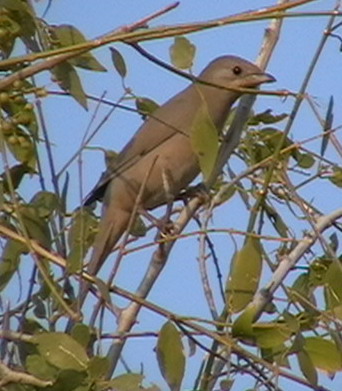- Hypocolius
Taxobox
name = Hypocolius
status = LC | status_system = IUCN3.1

image_width = 240px
image_caption = Female Hypocolius on the tooth brush tree ("Salvadora persica")
regnum =Animal ia
phylum = Chordata
classis = Aves
ordo =Passeriformes
subordo =Passeri
familia = Hypocoliidae
genus = "Hypocolius"
genus_authority = Bonaparte, 1850
species = "H. ampelinus"
binomial = "Hypocolius ampelinus"
binomial_authority = Bonaparte, 1850The Grey Hypocolius ("Hypocolius ampelinus"; alternative name Hypocolius) is a smallpasserine bird species . It is the sole member of the genus "Hypocolius" and family Hypocoliidae.Taxonomy
The relationships of the species are unclear. They may be related to the
waxwing s, and some authorities place them in that family, but others believe their closest relatives are thebulbul s.Description
The Hypocolius is a slim bird with a long tail, slight crest and thick, short bill. Its shape and soft, satiny
plumage resemble thewaxwing s'. Birds are mainly a uniform grey or brownish-grey colour, with males having a black triangular mask around the eyes. They have white-tipped black primary wing feathers and a black terminal band on the tail. Adults are about 18-23 cm in length and weigh 28-55 g.Distribution and habitat
The Hypocolius ranges through the
Middle East , breeding in theIraq ,Iran ,Afghanistan ,Pakistan ,Turkmenistan area, and wintering mostly near theRed Sea andPersian Gulf coasts ofArabia , includingBahrain . It is a vagrant toTurkey ,Israel ,Egypt andOman . It is found in woodland and scrub in arid and semiarid regions, especially river valleys near deserts, as well as in irrigated and cultivated areas with trees, such as palm groves and gardens.Meinertzhagen. (1954). "Birds of Arabia". Oliver & Boyd: Edinburgh.] [http://www.iucnredlist.org/search/details.php/52307/all IUCN Red List: Grey Hypocolius] ]Behaviour
The Hypolcolius is a shy and unobtrusive, even cryptic, bird which will fly to thick cover when disturbed, where it will remain motionless until the perceived danger has passed. Its flight is strong and direct. It will form flocks, especially in winter, and roost communally. [http://animals.jrank.org/pages/1138/Waxwings-Silky-Flycatchers-Bombycillidae-GRAY-HYPOCOLIUS-Hypocolius-ampelinus-SPECIES-ACCOUNTS.html Animal Life Resource: Grey Hypocolius] ] King, Howard. (1997). "Grey Hypocolius - a Bahrain Experience". [http://www.hawar-islands.com/hypocolius.html] ]
Breeding
The nest is a large, untidy structure built up to 4 m above the ground in a thick bush or immature palm . It has a deep cup lined with soft material. The clutch is 3-4 glossy white eggs, sometimes with pale brown blotches at the larger ends, and the incubation period 14-15 days.
Feeding
Hypocoliuses forage quietly and methodically in foliage, through clusters of trees, palm groves and orchards, rarely coming to the ground. Though they may eat some insects, their main diet consists of fruits and berries, including mulberries,
fig s and dates. When chewing fruit pulp, they leave a trail of the debris of discarded seeds and skins behind them on the ground.Call
One of their calls is a soft, cat-like mewing.
Conservation
Because the species has a large range, and because it does not meet the population size and decline criteria of the IUCN Red List, the conservation status is evaluated as being of
Least Concern . Because of its monotypic family status it is much sought after by birdwatchers. However, it is not an easy bird to study, there are few specimens in museums, and the political difficulties in getting into and around any of the countries in its range are formidable.References
* Database entry includes justification for why this species is of least concern
External links
* [http://www.montereybay.com/creagrus/hypocolius.html Hypocolius birding info and photos]
* [http://ibc.hbw.com/ibc/phtml/especie.phtml?idEspecie=5699 Hypocolius videos] on the Internet Bird Collection
Wikimedia Foundation. 2010.
